Los Angeles Pacific Railroad
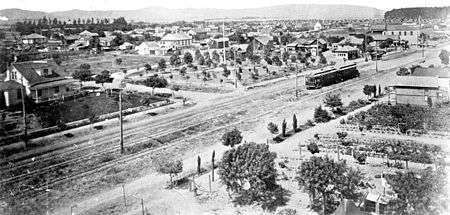

Los Angeles Pacific Railroad (1899−1906) was an electric railway and steam locomotive public transit and cargo shipping railway system in Los Angeles County, California. At is peak it had 180-miles of track from Pasadena, through Downtown Los Angeles, the Westside, and Santa Monica, then to the South Bay towns along Santa Monica Bay.
History
The Los Angeles Pacific Railroad was established in 1899 by 'General' Moses Sherman and Eli P. Clark. Clark served as President of the company.
The rapid interurban transit of the Los Angeles Pacific Railroad brought many new developments and residents to the Los Angeles region, along with the larger Pacific Electric Red Cars (PE) system that reached across the Greater Los Angeles.
On June 16, 1903, the Los Angeles Pacific Railroad merged with the Los Angeles-Santa Monica Railroad Company and the Los Angeles, Hermosa Beach and Redondo Railway Company. The new name after this merger was the Los Angeles Pacific Railroad of California, but everyone still just called it the Los Angeles Pacific Railroad. The Los Angeles-Santa Monica Railroad Company was incorporated on December 2, 1902.[1][2]
On March 19, 1906, an agreement was reached to sell all the Los Angeles Pacific Railroad lines for $6 million to the Pacific Electric Railway, owned by Henry Huntington. PE continued operating its electric railway lines in Pasadena, Los Angeles, and the Westside.[3] By 1911 the Los Angeles Pacific Railroad's steam locomotive lines were divested by PE.
Lines
Los Angeles Pacific Railroad passenger cars operated in the cities of Los Angeles, Pasadena, Hollywood, Sawtelle, Santa Monica, and Ocean Park.
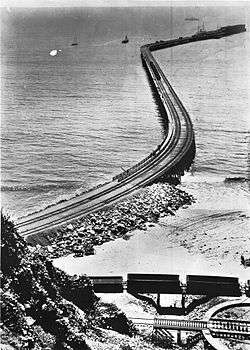
Freight would be moved on the same lines but between midnight and morning. Regular freight consisted of oil from the Sherman Oil District west of Hollywood, and lumber from the Long Wharf in Santa Monica. Sherman also bought parcels of land west of Downtown Los Angeles, out to the ocean, and down the coast to present-day Redondo Beach.
In 1906 the company owned and operated 405 cars: 144 passenger cars, 6 parlor cars, 17 electric locomotives, 221 freight cars, 5 mail cars and 12 repair service cars.

Los Angeles Pacific Railroad Steam locomotive line ran from Los Angeles to Santa Monica, with stops in Hollywood and Colegrove.
Los Angeles Pacific Railroad ran the: Los Angeles Pacific Railroad, Sherman line, Balloon Route Trolley Trip,[4] Port Los Angeles-Santa Monica Canyon Line, Venice Short Line, Redondo Beach via del Rey Line, Western-Franklin-Brush Canyon Line, Westgate Line (Brentwood), Lagoon Line, Santa Monica Air Line, Coldwater Canyon Line, Hollywood Boulevard Line, Santa Monica Boulevard Line, Hill Street Station, Los Angeles-Vineyard Local Service, Sherman Car House and Shops (including the West Hollywood Car House), Hill Street Tunnels, Vineyard-Beverly Hills-Sawtelle-Santa Monica Line, Echo Park Line, Glendale-Burbank Line, Edendale Line-Edendale-Atwater Line, Canoga Park Line, San Fernando Line, Van Nuys Line, Subway Terminal Building and the Subway, Freight Service, Inglewood Line, Owensmouth Line, and Los Angeles-Hollywood-Beverly Hills-Venice Line.
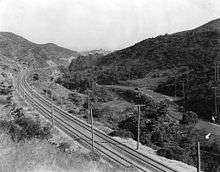
On December 15, 1899 a line was started down Prospect Avenue from downtown Los Angeles to Hollywood. Prospect Avenue would be renamed Hollywood Blvd in 1910. Prospect Avenue was built in 1887.
When Brentwood Park was being built the Los Angeles Pacific Railroad built tracks for the Westgate Line of Red Car service in 1906. This electric trolley ran from San Vicente Boulevard to Ocean Avenue (Santa Monica) and then turned south to the Santa Monica Main Line.
The Santa Monica Short Line (Venice Blvd, San Vicente Blvd, Santa Monica Blvd) and the Venice Short Line (Venice Blvd, Trolley Way, Ocean) took away much of the Southern Pacific and Atchison, Topeka and Santa Fe Railway passenger business.
Los Angeles Pacific Railroad lines inaugurated the line between Los Angeles and Redondo Beach in August, 1903.
The current Sherman Way (Los Angeles Metro station) is on the right-of-way of an old LAP line. Sherman Way is named after General Sherman, due his land development and rail lines he built in the valley.
For the lines out to the San Fernando Valley from Hollywood he built two tracks lines over the Cahuenga Pass and up Vineland Avenue through North Hollywood, turning onto Chandler Boulevard, proceeding west to the curve onto Van Nuys Boulevard, through Van Nuys to a curve (Sherman Circle) off of Van Nuys Boulevard, then turning west onto Sherman Way to Owensmouth, (present day Canoga Park).
Balloon Route


The Balloon Route Trolley trip was a featured route of the The Los Angeles Pacific, and opened in September, 1901. The line ran from downtown Los Angeles through Hollywood, Santa Monica, Venice Beach, Redondo Beach and back to Los Angeles via Palms. The lines stopped at beach resorts and included free entrance to some en-route stops and attractions along the way. Stops included: the Sunset Boulevard studio of painter Paul de Longpré, the bean fields of Morocco in Beverly Hills, Old Soldiers' Home in Sawtelle, Long Wharf, Camera Obscura at Santa Monica, Playa del Rey Pavilion for a fish dinner, Redondo's Moonstone Beach, Venice, and Palms. The street car departed downtown Los Angeles at 9:30 am each day and returned to Los Angeles at 5:00 pm for the cost of $1.00. This excursion line was heavily advertised and thus became well known. The first car used was a Parlor car (#400), and as the line became popular more cars were added. The owner of Hollywood's first Hotel, the Glen-Holly Hotel, operated the line for the LAP. In 1906 the PE took ownership and operation of the line. One add noted: "10 dollar tour for one dollar"[5][6] The Balloon Route Streetcar Depot, West Los Angeles is National Register of Historic Places since in 1972.
Old Mission Trolley

The other special route was the Old Mission Trolley trip, that ran from Downtown Los Angeles to Pasadena then to the Mission San Gabriel Arcángel, returning to Los Angeles at 5:00 pm. This line also included free entrance to some en-route attractions along the way, such as Pasadena Citrus packing houses, at a cost of $1.00.[7]
Offices and buildings
In 1898 Los Angeles Pacific Railroad built a rail yard midway along the western routes, where the present day Pacific Design Center stands on Melrose Avenue in West Hollywood. Other rail yards were at the Buena Vista freight depot and the Hill Street Station.
At the junction of the streetcar lines west of Hollywood, Los Angeles Pacific Railroad built car barns and founded a settlement named "Sherman". It eventually become the city of West Hollywood. The large 5.56 acre rail facility was on Santa Monica Boulevard just west of La Cienega Boulevard. The yard had a steam power house, a car barn and a repair shop building. In 1912 Pacific Electric Railway moved the streetcar yard to 7th Avenue & Central in downtown Los Angeles.[8]
Electrical power for the system was provided by the company's central power station at Vineyard, using a Westinghouse Parsons steam turbine. Substations were at Bush Street and Burlington Avenue, West Olive Street, Ivy Park (Culver City), Playa del Rey, Hermosa, Ocean Park, and Sherman.
In 1900 the Los Angeles Pacific Railroad division headquarters moved to a $100,000 building at 314 West 4th Street next to the Broadway Department Store in Downtown Los Angeles, between Hill & Broadway. A fire on in 1908 destroyed the building.[9]
Acquisitions and mergers
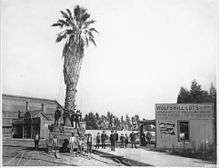


Los Angeles Consolidated Electric Railway
On October 14, 1890 Sherman founded the Los Angeles Consolidated Electric Railway in Downtown Los Angeles. He received a 50-year franchise from the city and sold stock to help build his street car railroad. In January, 1891 Sherman made is brother-in-law, Eli P. Clark, vice-president and manager of the Los Angeles Consolidated Electric Railway, the predecessor of the Los Angeles Pacific Railroad. The company built 47 miles of track radiating out around from Arcade Depot at 6th and Central Streets in downtown Los Angeles. The new company did well. The power for the street cars came from two Thompson-Corliss type oil steam engines, each with 700 horsepower, made by Golden State Miners’ Iron Works in San Francisco. Joseph W. Wolfskill sold a lot to the Los Angeles Consolidated Electric Railway for the Arcade Depot.[10] In 1899 the Los Angeles Consolidated Electric Railway became part of the Los Angeles Pacific Railroad, as steam trains and other rail lines were added to the system. Gen. Sherman purchased land that became the town the bears his name: Sherman Oaks, his land deals made him more money than his railroading.[8]

Pasadena and Los Angeles Electric Railway

Pasadena and Los Angeles Electric Railway Co. was incorporated by Sherman and Clark in April 1894. It then purchased all the rail lines running in Pasadena including City Railway Company of Pasadena and the Pasadena Street Railroad. On May 6, 1895 the line from downtown Los Angeles (Fourth and Spring streets) to Pasadena opened, running through the Arroyo Seco and South Pasadena. One of the popular stops on the line was the Cawston Ostrich Farm. The Pasadena to Downtown LA line was the first interurban line, "between cities".[11][12] The company also ran the Arroyo Seco Line 1.7 mile, that connected to the Southern Pacific RR at Broadway & Colorado. The Columbia Street Line ran from Raymond Hotel (South Fair Oaks) and the Santa Fe's South Pasadena Station. Clark had served has a director on the board and as a trustee. The line had 44 miles of tracks at it peak. Many of the horse-pulled cars were changed to electric. In May, 1895 a South Pasadena stop was added. In 1898 the company changed to the Los Angeles and Pasadena Electric Railway Company as Sherman & Clark lost control of the company to a Chicago Company.[13] The complete system was sold on March 10, 1902 to the Southern Pacific Company.[14][15]
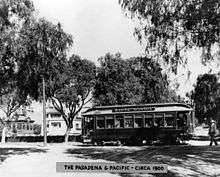

- West Pasadena Railway Company
West Pasadena Railway Company made the West Colorado & Orange Grove Avenue Line in 1891, this started as horse pulled car. West Pasadena Railway Company was sold to the Pasadena and Los Angeles Electric Railway, who electrified the line. The line was 2.5 miles long. It ran on Colorado Blvd, Fair Oaks, Orange Grove, Los Robles Avenue. PE abandoned the line in 1923.
- Colorado Street Railway
Colorado Street Railway made the East Colorado Street Line in 1886. This line started with horse-pulled cars. Colorado Street Railway sold the line to the Pasadena and Los Angeles Electric Railway, who electrified the line. The line was 3.3 miles long. It ran on Fair Oaks Avenue to Daisy Avenue in Lamanda Park. PE abandoned the line in 1941. Colorado Street Railway also made the South Loop Linein 1888. It was electrified in 1894 by the P&LA. PE turned the 1.5 mile line into the Tournament Park Line, abandoned in 1923.
George Swartwout's 1888 Highland Railroad was sold to the Pasadena and Los Angeles Electric Railway in 1894. Started as a horse line and electrified in 1894, it ran Villa Street to New York Avenue. Major stops: Raymond Hotel (Raymond Station North) to Raymond and Colorado, passing the Pasadena Grand Opera house on the way, 2.3 miles. North Loop Line was also mad by the Highland Railroad, ran Los Robles, Villa, Lake and Colorado, 1.7 miles.[16]
In 1896 Professor Thaddeus S. C. Lowe ceded control of the his Pasadena & Mount Wilson Railroad,[17] Mount Lowe Railway, that took visitors high in the Angeles National Forest to the Pasadena and Los Angeles Electric Railway Co. Due to high maintenance cost he was not able keep it going. Pasadena and Los Angeles Electric Railway kept the name the same: Pasadena & Mount Wilson Railroad Co. Along with high operating cost, in 1896 Lowe lost a franchise to build an electric railway from Altadena to Pasadena; the franchise went to the Pasadena & Los Angeles Electric Railway. When the line was in control of PE after the March 10, 1902 sale, it was closed in March 1938 after a flood.[18][19][20]
Pasadena Street Railroad Company
and
City Railway Company of Pasadena
Built and ran the North Fair Oaks Avenue Line from Colorado Street north to Mariposa it turned East to Lake Avenue. It ran double track for 4.28 miles. This was a horsecar line built in 1886 that ran from Colorado to Chestnut by Pasadena Street Railroad Company a 3'-6" gauge track. City Railway Company of Pasadena built in 1887 the horsecar line from Chestnut to Mountain View Avenue. Both lines are purchased in 1894 by Pasadena and Los Angeles Electric Railway. The line was changed to electric in 1894 by Pasadena and Los Angeles Electric Railway from Colorado Street to Montana Street. Southern Pacific Company ran the line out to Mariposa & Lake in 1903. The line ended in 1952.[21]
Pasadena and Pacific Railroad

The Pasadena and Pacific Railroad Company (P&P) was started in 1895 by Sherman, this company built a line from downtown LA to Santa Monica. In 1898 Pasadena and Pacific Railroad became part of the Los Angeles Pacific Railroad.[22]
Port Ballona and the Redondo and Hermosa Beach Railroad
- Port Ballona made by Louis Mesmer and Moye Wicks, today's Marina Del Rey, their plans were also to have this be the site of a major port. A street car tram line was made to the Port by the Redondo & Hermosa Beach Railroad company, that had incorporated on February 21, 1901. This company was part of the Los Angeles Pacific Railroad. The tram line opened December 1902 departed downtown at 4th & Broadway. Sherman purchased 1,000 acres of land around the Ballona lagoon and Port Ballona in 1902 under the name the Beach Land Company. Sherman and Clark renamed the land "Del Rey". Port Ballona was then renamed Playa Del Rey.[23][24] The port was also was serviced by the California Central Railway opened in September 1887, this line later became the Santa Fe Railway, that later became the Atchison, Topeka, and Santa Fe Railroad. The rail line ran from the port to Redondo junction
See also
- Sunset Junction, Los Angeles
- Streetcar suburb
- List of California street railroads
- Streetcars in North America
- List of California railroads
- History of rail transportation in California
- Union Station (Los Angeles)
- Los Angeles Motordrome
- Pacific Electric's Red Cars that connected
- Los Angeles and Independence Railroad
References
- ↑ Electric Railway Historical Association of Southern California, Los Angeles Pacific Corporate Histories
- ↑ erha.org, Electric Railway Historical Association of Southern California, Los Angeles Pacific
- ↑ erha.org Los Angeles Pacific history
- ↑ erha.org balloon Trip
- ↑ erha.org Balloon Route line
- ↑ The Great Pacific Electric, by William D. Middleton
- ↑ Metropolitan, Volume 12, Page 920, Bobit Publishing Company, 1916
- 1 2 Masters, Nathan. (01 December 2011). "West Hollywood at 27: How the Town of Sherman Became WeHo". SOCAL FOCUS blog. Accessed 08 November 2012
- ↑ LAFire.com: Los Angeles Fire Department Historical Archive, LAFD PHOTO ALBUM COLLECTION; The Los Angeles Pacific Railroad Depot Fire, 4th street between Hill & Broadway; November 15, 1908
- ↑ erha.org Los Angeles Consolidated Electric Railway, started in 1890, California Illustrated, 1892
- ↑ Pacific Electric Red Cars, By Jim Walker, page 10
- ↑ erha.org South Pasadena Local Lines
- ↑ erha.org Pasadena & Los Angeles Electric Railway - Los Angeles & Pasadena Electric Railway
- ↑ Ohio State Press, Trolleys, Real Estate, and Electric Power, 1898-1903, Ch. 4
- ↑ Los Angeles Herald, Volume 26, Number 237, 25 May 1897
- ↑ Mount Lowe Railway, By Michael A. Patris, page 8
- ↑ erha.org Mount Lowe Line
- ↑ PUBLIC TRANSPORTATION TO LOCAL NATIONAL FORESTS, by Ron Frescas, Chris Martin, and Christine Steenken, University of Southern California Dr. Steve R. Koletty, Prepared for the Center for La w in the Public Interest, April 15, 2004 (book as typo 1886 should be 1896, Lowe control lost)
- ↑ Digital Library Consulting, Los Angeles Herald, Volume 25, Number 271, 29 June 1896, Pasadena and Los Angeles Electric Railway and Mount Lowe Railway timetable.
- ↑ The Land of Sunshine: A Southern California Magazine, Volume 5, 1896
- ↑ erha.org Pasadena Local Lines
- ↑ Pacific Electric Red Cars, By Jim Walker, page 9.
- ↑ erha.org Los Angeles Pacific Corporate Histories
- ↑ delreync.org, Del Rey Neighborhood Council, Marina Del Rey History
- Pacific Electric Railway Volume 4: Western District by Donald Duke
- New Depot for Los Angeles Pacific Railroad
- Los Angeles Pacific Corporate Histories
- expogreenway.org
- Los Angeles Pacific: Electric Railways of Hollywood & Santa Monica Bay Cities Paperback – January 1, 1955
- Los Angeles Pacific Railroad Company of California, 1897 - Los Angeles (Calif.) - 34 pages long.
- antasusannadepot.org Southern Pacific Railroad’s Newport Beach Wharf Depot
- CITY TRANSIT HISTORY (SANTA MONICA)
- Electric Railway Journal, Volume 35. page 1044, Clark steps down.
- Annual Report of the Board of Railroad commissioners of the State of California By Board of Railroad Commissioners of the State of California
- Out West, Volume 30, By Charles Fletcher Lummis, Makers of Los Angeles, page 331.
- Trolleys to the Surf: The Story of the Los Angeles Pacific Railway, by William A. Myers, Ira L. Swett
External links
![]() Media related to Los Angeles Pacific Railroad at Wikimedia Commons
Media related to Los Angeles Pacific Railroad at Wikimedia Commons